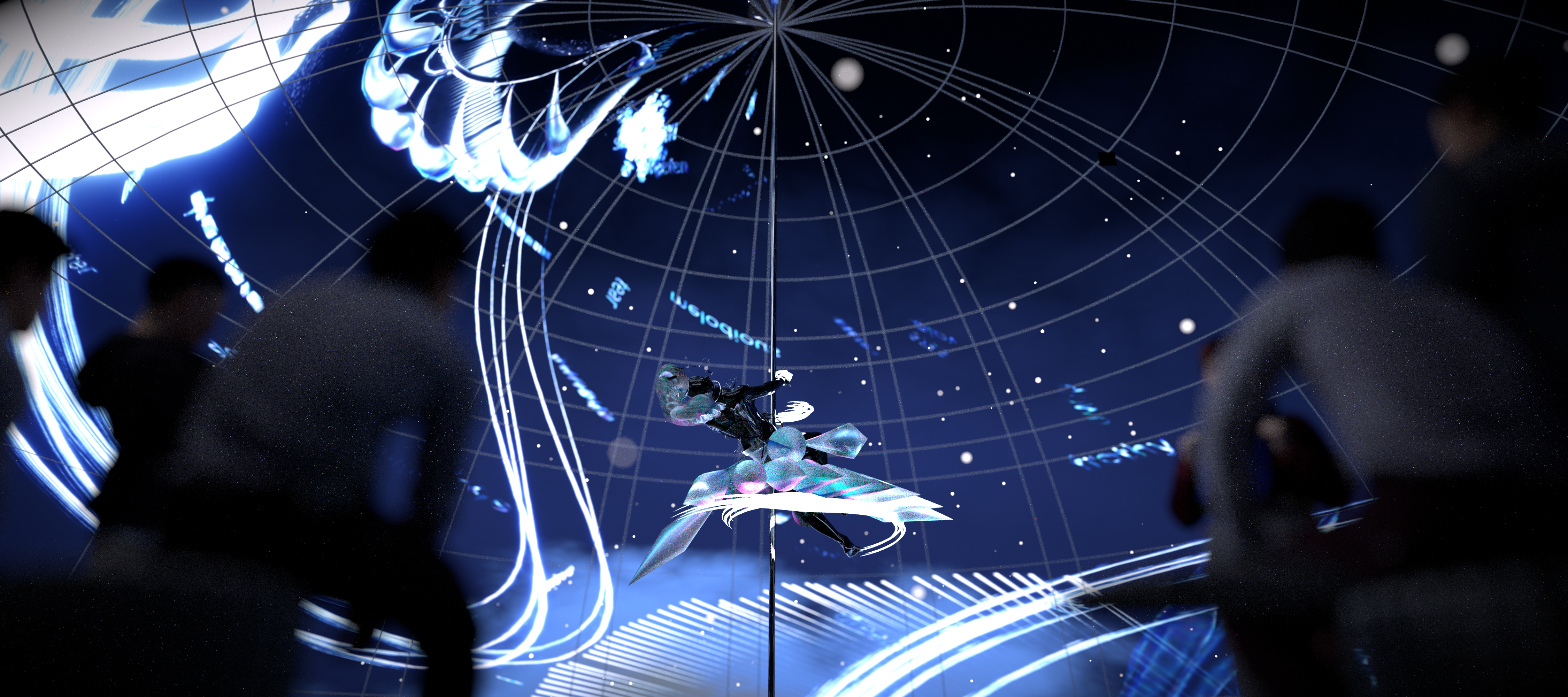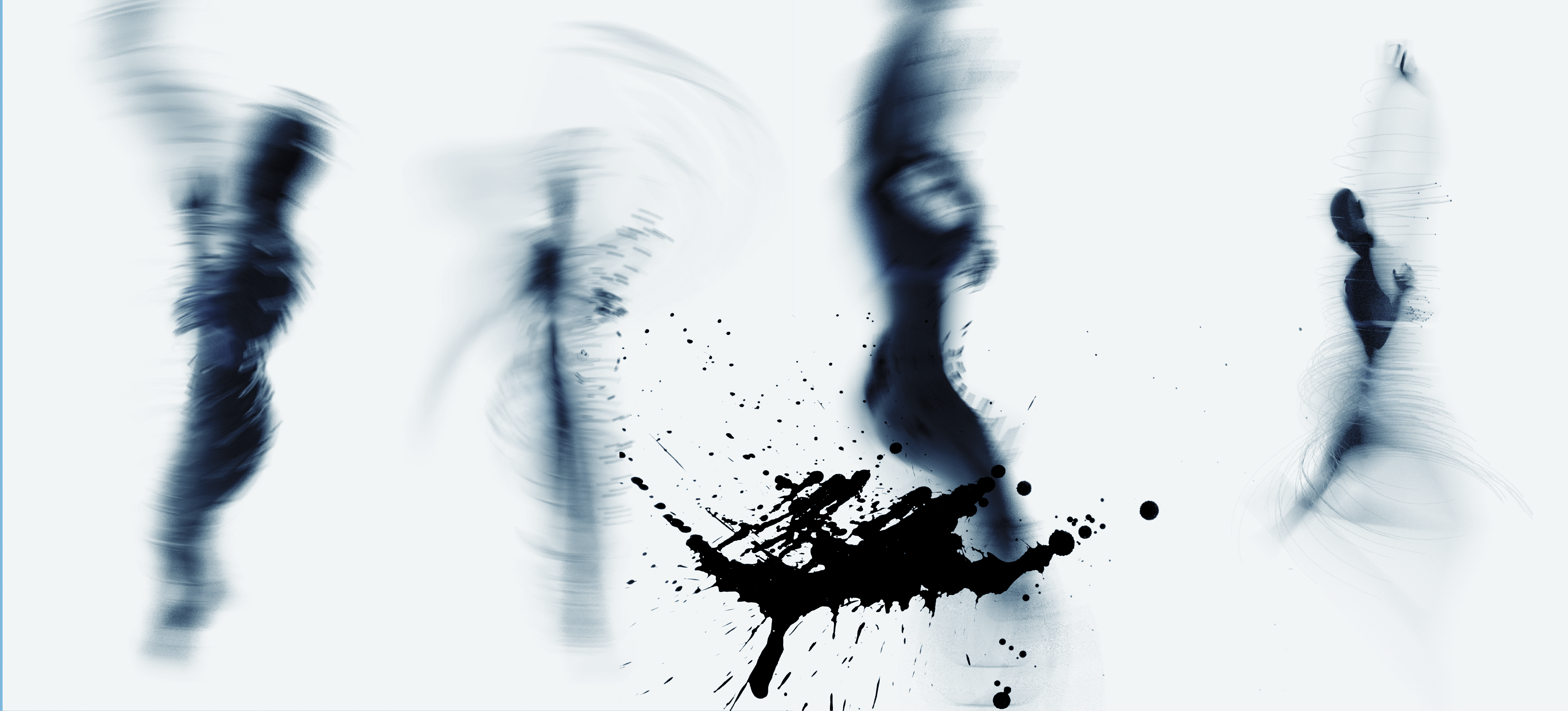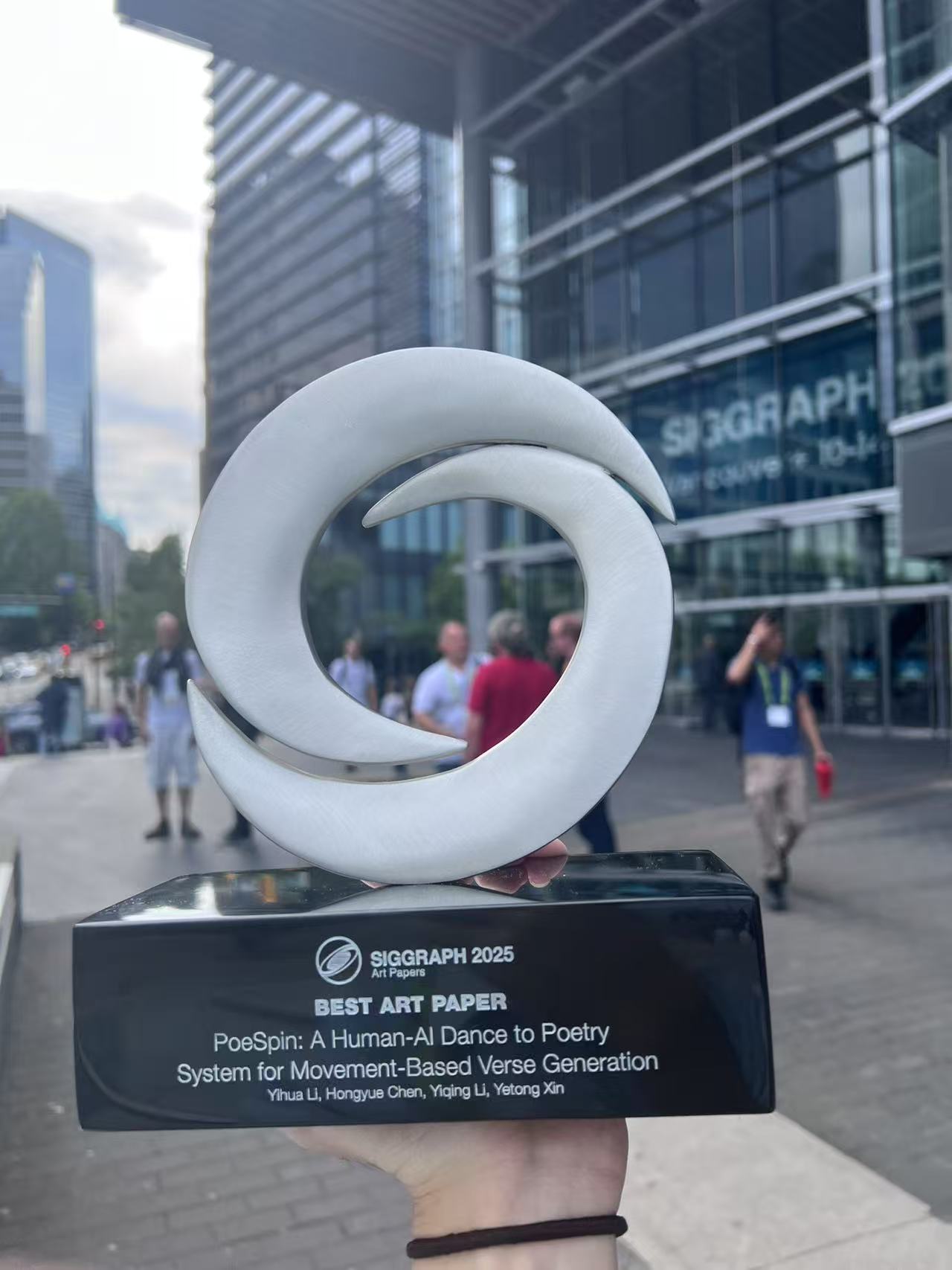Human-AI Cocreated writting system / CGI / Projection Mapping / Mocap
Poespin-Wherever your body reach, there is a poetry

"HOW CAN WE KNOW THE DANCER FROM THE DANCE?"- Yeatz (1865-1939)
PoeSpin is a human-AI cocreating writting system that transforms ‘pole dancing’ movements into poetry, blending Eastern and Western artistic traditions. Our project uses three innovative approaches:
- AI-driven poetry composition inspired by dance, incorporating the circular Chinese “Lianhuanshi” (连环诗) form / “Chinese ring poetry” to reflect pole-dance’s rotational nature.
- The reduction of the dimensions of word vectors creating the space for dancers to experiment with ‘automatic writting’.
- The expansion of the dimensions of the captured body movement as an exploration of semantic meanings
By fusing W. B. Yeats’ poetry and Chinese poetic structures, PoleSpin creates a unique narrative that bridges cultures. It reimagines dance as a universal expression, and is projected into verses, which embodies both physical grace and cultural heritage.
This is also the 1st ‘dance to poetry’ art project to interpret pole dance through computational linguistic perspective.

MUSE DESIGN 2024 AWARD GOLD WINNER

2024 NeuralPS Creative AI track

2024 Chinese CHI Art Gallery

2024 Aspace Gallery

2025 BEEPLE DIGVERSE

2025 NYC ARTTECHHOUSE
 2025 CVPR AI Art Gallery
2025 CVPR AI Art Gallery
 2025 SIGGRAPH LONG ART PAPER(Overall Recommendation:4.7/5.0 Expertise:2.7/3.0)
2025 SIGGRAPH LONG ART PAPER(Overall Recommendation:4.7/5.0 Expertise:2.7/3.0)
2025 Digital Design Days
Prompt Magzine

2025 NYU Global Show&Tell
Siggraph 2025 Long Art PaperYihua Li, Hongyue Chen, Yiqing Li, and Yetong Xin. 2025. PoeSpin: A Human-AI Dance to Poetry System for Movement-Based Verse Generation. Proc. ACM Comput. Graph. Interact. Tech. 8, 3, Article 35 (August 2025), 13 pages. https://doi.org/10.1145/3736781
Mentor:
Prof. Allison Parrish - NYU ITP/IMA: https://rwet.decontextualize.com/
Prof. Marcel Oliver-Rose Truxillo: https://linktr.ee/mrt439
Team:
Cory Yihua Li(Director,AI Writting System,CGI)
Wendy Li(Poet on the pole, Choreographer)
Jiayi Li(Animator, Rigging, Cloth Design)--NYU ITP
Archy Hongyue Cheng(English Literature&Poetry Consultant)--Universität Freiburg English Literatures and Literary Theory
Reraner Yetong Xin (Curator,Art Director,3D Art CGI)--Harvard GSD
Armon Naeini (Creative Technologist / TouchDesigner Coder)-- NYU ITP
Consultant & Main Reference:
Cheesetalk(Yuqian Sun)--AI Nvshu https://dl.acm.org/doi/10.1145/3610591.3616427,
Weidi Zhang--Cangjie's Poetry https://dl.acm.org/doi/fullHtml/10.1145/3465619
Photo&Video Documentation:Baiyuan Xin --NYU ITP
Music & Sound Design: Cardin An Chung--USC Thornton
Technical Assistant:
Henry Beach-Artechouse
Poetry Examples
Version I AI Agent (BLIP Vision Recognition +Claude AI) ring poetry strategy数星无言夜渐深 言夜渐深谁共鸣 深谁共鸣言夜渐 渐深夜言无星数 Counting stars and the silent night is getting darker As the night gets darker, who resonates? Deep words fade into the night It's getting late and there are no stars left
![]()
Version II
Word Vector
Dimensional Reduction Space Strategy
Stanza 1:
eternal beauty cry cry ever wander
trouble within gloom sing peace wage
name friend dance ever singe
bid strike dance into peace
Stanza 2:
tell praise secret spirit die leave
from girl within gloom cushioned place eternal beauty
dance dance before dawn name friend
dance into peace bid
Stanza 3:
heavy story toil poor child
overhead pace labour cushioned place sing peace
before dawn ever singe dance
name friend strike dance
Stanza 4:
yet turn leave sad beauty
mistake gratitude with sorrow inland valley
ever singe dance before dawn name
into peace name friend bid strike

Version III Motion Capture Data (Dimensional Increasing by Fourier transform) Mapping to High Dimensional Space Stanza 1: wizard song murmur song give melody many shore barter half write pass worm weave on hope gentle feeling like tooth away go exchange opinion for bee for creak by storm for thee Stanza 2: at hour from child human child chaplet olden dance bend head show twist maybe lift still leave pull long hair from eye ever grieve still flare quiet Stanza 3: brown dear lovely thing drink consume bring hound hapless faun from unwet plant on sea take man now take unhaunted sleep you come again! love soul lip still go pitch future day Stanza 4: now have up go change shine golden grasshopper sweat wet leave own will dip new ease sing bribe leafy island wander wood![]()
1. Initial Conception
Inspired by Martha Graham, the mother of modern dance, who said: 'DANCE IS THE HIDDEN LANGUAGE OF THE SOUL', we posed a question:
"How can we transform dance into poetry?"
Dance may represent the most primitive and direct form of human expression. It is not only an art form but also a means of communication rooted in our biological instincts.
This project aims to make an initial attempt at translating dance into poetry using a specific dance form: pole dancing. We collected motion capture data of pole dancer Wendy Li at the NYU Motion Capture Laboratory. By combining dance semantics and cultural background for data processing, we aim to explore the connection between human behavior and computational semantic space, and create a Dance to Poetry AI Art System.
Through observation, we found that pole dance movements are primarily circular. Dancers showcase their postures using core strength and limb extension/contraction, with climbing and inverted positions as expressive forms. Dance movements have unique and highly creative names: Flamingo, Full Moon, Phoenix... (https://www.onlinepolestudio.com/moves/pole/alphabetical/)
Based on these spatial and cultural semantic features, we initially developed three approaches:



2. Corpus Construction
William Butler Yeats (1865-1939) was an Irish poet, dramatist and writer, and won the 1923 Nobel Prize for literature. As a symbolist poet, he often used allusive imagery in his poems and later built his own symbolic systems in A Vision (1925). As Gale Research International commented, “His use of symbols is usually something physical that is both itself and a suggestion of other, perhaps immaterial, timeless qualities.”
Among the symbols he has been using, dance has a significant role both in his theatrical plays and his poems.
3.1 Among the poets, why do we pick Yeats particularly?
Among the English symbolist poets, Yeats’s work caught our attention immediately for its reflection of both western tradition and eastern heritage. On the one hand, as a successor of the English Romantic transition, Yeats sought for the connection between writing and vision in his experiments of automatic writing. On the other hand, as a scholar who is fascinated by eastern culture, he often borrowed exotic images from Japanese and Chinese traditional dances, such as masks and various forms of dance, and integrated them into his work.
3.2 What is dance to Yeats? What is Yeats's perception of dance?
As Jones summarized in the Oxford Handbook of W. B. Yeats:
“Dance in Yeats’s writing embodies a range of preoccupations, ideas, and states of being, variously referring to shifting historical change, memory, an expansion of consciousness, and giving access to forms of transcendence, expressions of eternality, insanity, or violence.”
Dance is not only one of the most important symbols in Yeats's poetry but also a crucial component in Yeats's theatrical performances. In other words, Yeats’s works provide a platform for the lyrical movement and the dancers’ movement to communicate with each other. Not only the written texts could be visualized through dances, but the “inner rhythm of the body” could also find its way to express outwardly through texts.
This is also what we want to achieve through this project–enabling dancers to speak through poetry. As the image of dance constitutes a significant part of Yeats’s poems, it also corresponds to our needs of constructing a dance-relevant resource pool, where the dancers’ modes of action can find their corresponding words.
3.3 Which poems did we choose?
As for the choice of poems for this resource pool, we have picked all Yeats’s poems that are related to dance. Besides, we have chosen other poems that are included in the same collection even though dance was not explicitly mentioned. Since for Yeats, the symbol of dance is also interconnected to other symbols, such as rose, the inclusion of other poems with the appearance of other symbols help enrich the meanings of dance in Yeats’ poetry.

3. Data Strategy

3.1 AI Agent as choreographer and Poet making Poem Cycle
Based on rotation angle => AI Agent (Vision API, BLIP Vision Recognition to identify the name of this movement) => Imagine dancer's intention → Form 2D circular poetry pattern) => One line for each tracker
"Lianhuanshi" (连环诗), or "Linked-Ring Poetry," is a unique form of Chinese poetry. It typically refers to poems where the characters are interlocked, like interconnected rings, hence the name "Linked-Ring Poetry."
The format of Lianhuanshi is usually arranged in a circular pattern. There's no limit to the number of characters used. There are many ways to read these poems, but generally, one starts from the central character at the top of the circle, then reads clockwise or counterclockwise. Every five or seven characters form a break, allowing the reader to create multiple five-character or seven-character poems. Some Lianhuanshi works can be read starting from any character. Following a specific pattern, numerous poems can be formed (often in the style of classical Chinese poetry with the same number of characters per line). https://baike.baidu.com/item/%E8%BF%9E%E7%8E%AF%E8%AF%97/1269439#:~:text=%E8%BF%9E%E7%8E%AF%E8%AF%97%EF%BC%8C%E6%98%AF%E4%B8%AD%E5%9B%BD%E8%AF%97,%E8%8B%A5%E5%B9%B2%E9%A6%96%E4%BA%94%E8%A8%80%E8%AF%97%E6%88%96%E4%B8%83%E8%A8%80%E8%AF%97%E3%80%82

3.2 Dimensionality reduction space
TSNE/PCA dimensionality reduction and word distributionLocal similarity, overall corpus structure => Tracker records
3.3 Motion capture data dimensionality increase
Based on high-dimensional spatial perspective (word vector dimensionality increase) => Motion capture of four points: 3D → 300D => Read at high speed to extract points, then correspond to certain words => Sentence fragments
4. Results Comprision
Along with our experiments, we have already generated different versions of results, which have propelled us to constantly adjust our strategies.
Instead of purely generating texts through dancing, we also want it to be readable and make sense to the readers to some extent. Therefore, besides relevant themes, it is crucial to choose the right form of poetry. In general, as Yeats’s poems are often in the form of free verse, we naturally continued this form to speak to the free expression of the pole dance.
4.1 Adjustment Two: From non-stop lines to stanzas
The first version of generated poetry presented itself as a loose combination of words (see below), and it reveals two problems. Firstly, the frequency of grammatical mistakes needs to be decreased. More importantly, though we limited the words of a line within the range of eight to ten, we noticed that the non-stop lines hindered readers from sense-making.
In order to tackle it, we further divided the lines into stanzas. The caesura between the stanzas led to a psychological effect on the readers, who tend to make sense of the lines within a stanza. Besides, we limited each stanza to four lines and a whole poem with only four stanzas.
Our inspiration for the division of poems also comes from the dancers’ change of height during the pole dance. As the dancer frequently moves from the ground to the midair, rotating from the pole, the change of the height of their position could be used as a mark of the caesura between the stanzas. (Such division of the stanza is based on the assumption that the height of the dancer implies different expressions, which is open to doubt and discussion.)
Stanza 1:
eternal beauty cry cry ever wander
trouble within gloom sing peace wage
name friend dance ever singe
bid strike dance into peace
Stanza 2:
tell praise secret spirit die leave
from girl within gloom cushioned place eternal beauty
dance dance before dawn name friend
dance into peace bid
Stanza 3:
heavy story toil poor child
overhead pace labour cushioned place sing peace
before dawn ever singe dance
name friend strike dance
Stanza 4:
yet turn leave sad beauty
mistake gratitude with sorrow inland valley
ever singe dance before dawn name
into peace name friend bid strike
eternal beauty cry cry ever wander
trouble within gloom sing peace wage
name friend dance ever singe
bid strike dance into peace
Stanza 2:
tell praise secret spirit die leave
from girl within gloom cushioned place eternal beauty
dance dance before dawn name friend
dance into peace bid
Stanza 3:
heavy story toil poor child
overhead pace labour cushioned place sing peace
before dawn ever singe dance
name friend strike dance
Stanza 4:
yet turn leave sad beauty
mistake gratitude with sorrow inland valley
ever singe dance before dawn name
into peace name friend bid strike
4.2 Adjustment One: From single word to set phrases
And in order to decrease the frequency of grammatical mistakes, we replaced the random words in the resource pool with set phrases (as mentioned above, they are divided by the part of speech). As the number of words in each line is limited, the grammatical issues have appeared less. However, we are still looking for other methods to further decrease them, and if possible, make them fully disappear.
The version two above is the result based on these two adjustments.
4.3 The role of AI and LLMs in translation
In order to maintain the originality of the poetry, and impart the major responsibility of poetry composition to the dancing itself, we have, from the very beginning, limited the use of AI and LLMs. They could have been a way to eliminate the grammatical mistakes, but their involvement would totally reconstruct the order of the words and thus the possible semantic meanings.
Regarding that, we only used AI to translate the generated texts into different languages. Surprisingly, even though the generated texts were sometimes a weird juxtaposition of phrases, AI tried its best to make sense of such arrangements, and automatically fixed some grammatical problems during the process of translation, while still keeping the original style as much as possible. So far, the Chinese translation of the poems works the best in the respect of sense-making, possibly due to its syntactic looseness compared to European languages; the German version of the poems presents better rhymes. Both translations below are based on the poem of Version II.
Sektion 1:
Ewige Schönheit weint und verweilt für immer
Singe in Trauer Friedenslöhne
Name Freunde tanzen einmal singen
Kämpfe für den Streik, tanze in den Frieden
Sektion 2:
Der Geist, der das Geheimnis des Lobes verrät, stirbt und geht
Das Mädchen aus den Schatten, ewige Schönheit
Tanz vor dem Morgengrauen. Tanz. Namensfreunde
Tanze mit Frieden
Sektion 3:
Schwere Geschichten lassen arme Kinder leiden
Wo der Kopf tritt, polstert die Arbeit den singenden Frieden
Singen und Tanzen vor dem Morgengrauen
Namensfreunde schlagen Tanz
Sektion 4:
Doch dann drehte er sich um und verließ die traurige Schönheit
Falsche Dankbarkeit und Traurigkeit im Outback Valley
Einmal sang er vor Tagesanbruch den Namen des Tanzes
Freunde wollen im Namen des Friedens streiken
Ewige Schönheit weint und verweilt für immer
Singe in Trauer Friedenslöhne
Name Freunde tanzen einmal singen
Kämpfe für den Streik, tanze in den Frieden
Sektion 2:
Der Geist, der das Geheimnis des Lobes verrät, stirbt und geht
Das Mädchen aus den Schatten, ewige Schönheit
Tanz vor dem Morgengrauen. Tanz. Namensfreunde
Tanze mit Frieden
Sektion 3:
Schwere Geschichten lassen arme Kinder leiden
Wo der Kopf tritt, polstert die Arbeit den singenden Frieden
Singen und Tanzen vor dem Morgengrauen
Namensfreunde schlagen Tanz
Sektion 4:
Doch dann drehte er sich um und verließ die traurige Schönheit
Falsche Dankbarkeit und Traurigkeit im Outback Valley
Einmal sang er vor Tagesanbruch den Namen des Tanzes
Freunde wollen im Namen des Friedens streiken
第1节:
永恒的美哭泣并永远停留
悲伤中歌唱和平工资
名字朋友一起跳舞一起唱歌
为罢工而战,为和平而舞
第2节:
背叛赞美奥秘的灵魂死了,走了。
来自阴影的女孩,永恒的美丽
黎明前的舞蹈名字的朋友
与和平共舞
第3节:
悲惨的故事让贫困儿童受苦
头部踏入的地方,工作就铺垫歌唱的和平
黎明前唱歌跳舞
名字的朋友跳舞
第4节:
然后,他转身离开了那悲伤的美丽。
内陆山谷中的错误感激和悲伤
一天,黎明前,他唱起了舞蹈的名字。
以和平的名义罢工
永恒的美哭泣并永远停留
悲伤中歌唱和平工资
名字朋友一起跳舞一起唱歌
为罢工而战,为和平而舞
第2节:
背叛赞美奥秘的灵魂死了,走了。
来自阴影的女孩,永恒的美丽
黎明前的舞蹈名字的朋友
与和平共舞
第3节:
悲惨的故事让贫困儿童受苦
头部踏入的地方,工作就铺垫歌唱的和平
黎明前唱歌跳舞
名字的朋友跳舞
第4节:
然后,他转身离开了那悲伤的美丽。
内陆山谷中的错误感激和悲伤
一天,黎明前,他唱起了舞蹈的名字。
以和平的名义罢工
セクション 1:
永遠の美は泣き、永遠に残る
悲しみの中で平和を歌う
友人の名前をつけてダンスを一度歌う
平和へのストライキダンスのために戦う
セクション 2:
賛美の秘密を語る精神は死に、去る
影から現れた少女、永遠の美
夜明け前にダンスを踊る 友人の名前をつけてダンス
平和と踊る
セクション 3:
重い物語は貧しい子供たちを苦しめる
頭が踏み出す場所 労働クッション 平和を歌う
夜明け前に歌い踊る
友人の名前をつけてダンスを踊る
セクション 4:
しかしその後、振り返って悲しい美を去った
偽りの感謝と悲しみ アウトバック バレー
かつて夜明け前にダンスの名前を歌った
友人は平和の名の下にストライキを命じる
永遠の美は泣き、永遠に残る
悲しみの中で平和を歌う
友人の名前をつけてダンスを一度歌う
平和へのストライキダンスのために戦う
セクション 2:
賛美の秘密を語る精神は死に、去る
影から現れた少女、永遠の美
夜明け前にダンスを踊る 友人の名前をつけてダンス
平和と踊る
セクション 3:
重い物語は貧しい子供たちを苦しめる
頭が踏み出す場所 労働クッション 平和を歌う
夜明け前に歌い踊る
友人の名前をつけてダンスを踊る
セクション 4:
しかしその後、振り返って悲しい美を去った
偽りの感謝と悲しみ アウトバック バレー
かつて夜明け前にダンスの名前を歌った
友人は平和の名の下にストライキを命じる
5. Conclusion
Polespin is an attempt to translate dance into poetry, where the body movements are projected as verbal speech, and the height of the bodies as caesura between the stanzas. Polespin is also a trial to set a stage for the communication between and the fusion of two art forms. The common meaning space we have built targets at dissolving the boundaries of the two forms. As the dimensionality of words decreases, the dimensionality of the body movement rises, and they both fall into this meaning space and meet each other.
Instead of treating it as a compromise from both sides, we perceive it as a mutual fulfillment. The inner rhythm of the body finds its way to express outwardly, and the lyrical texts could find its trace in the visual space.
From the results, we could see that the generated Chinese ring poem presents a post structuralist reading of text and pole dance, since we could start from different characters to navigate the poetry and also from different parts to understand pole dance.The generated English poem reveals a structuralist perspective of understanding pole dance. Each pole dance posture points towards one or several set phrases in the meaning space, and therefore the movement of the dancers could constitute a unique poem.
Finally, Polespin is also a response to Yeats’s question posed in his Among School Children, “How can we know the dancer from the dance?” Our possible answer is: the dancer speaks (in Yeats’s words).

Nanjing Deji Art Museum Digiverse(with Beeple)



NeurIPS2024 Creative AI Track


NYC ARTECHOUSE ‘Submerge’ Exhibition



























Wherever your thoughts could reach,
there’s the poetry!
--
Poespin
- End -
Yihua Li and my people who support us all along the way
2025.8.14 Vancouver * New York
 数星无言夜渐深
言夜渐深谁共鸣
深谁共鸣言夜渐
渐深夜言无星数
Counting stars
and the silent night is
getting darker
As the night gets darker,
who resonates?
Deep words fade into the night
It's getting late
and there are no stars left
数星无言夜渐深
言夜渐深谁共鸣
深谁共鸣言夜渐
渐深夜言无星数
Counting stars
and the silent night is
getting darker
As the night gets darker,
who resonates?
Deep words fade into the night
It's getting late
and there are no stars left

